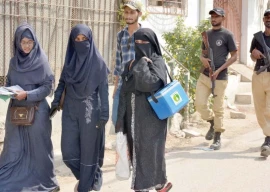
Of concern is the fact that close proximity - haphazard and ill-planned merging of commercial structures such as banks and departmental stores with residential areas - is increasingly putting lives at risk in residential precincts.
This trend has also heightened in the wake of the commercialisation of major traffic corridors in Karachi in the form of ‘strip’ or ‘ribbon’ commercialisation, with commercial footprint extending inwards with no planning or regulatory controls in place.
The geography of criminology
The recognition of crime hot spots (Sherman et al., 1989) was perhaps a watershed in refocusing attention on spatial features of crime. Ogborn (1993) describes the relationship between criminology and geography as follows: “Policing arrangements are inherently geographical phenomena. Scrutinising the place of the criminal event is focal point for geographers. They are keenly interested in understanding of land usage, street design and traffic patterns, while they also focus towards routine activities and movement of offender and victim.”
Geography of criminology focuses on criminal patterns within particular built environments and analyses the impacts of these external variables on people’s cognitive behavior. As such, the approach defines a field of reference for geographers who use local environments to explain crime (Herbert and Hyde, 1985).
The eventual aim of such an analysis is multidisciplinary; for security services such as the police to adapt strategies according to the incidence of crime, for town planners and architects to create safe environments, and for sociologists and welfare services to neutralise the role of negative environments in a social behavior.
The Study
A Research Paper - Role of Traffic Network in Monitoring Crime and Violence Patterns in Karachi prepared by a team of University of Karachi department of geography’s Prof Dr Jamil H Kazmi, and research scholar Umair-Bin-Zamir has highlighted this issue by assessing the potential of Geographical Information Systems (GIS) mapping for the analysis of crime patterns and its relationship with the road network and land use in Karachi.
The paper provides a collective set of methods and techniques for geospatial analysis and 3D mapping of crime scenes selecting PECHS (Blocks 2 and 3), which has been badly hit by unplanned spread of commercialisation in former residential districts. An assessment of relationships between selected crimes clusters and their spatial neighbourhood is investigated in the study, by including urban land use as a backdrop.
The methodology of the study was implemented in two phases. The first phase determined the general identification of hotspots developed through the periodic records of police data, by using the interpolation technique in GIS environment. while the second involved field survey, gathering of illustration in order to bring out the relationship of crime activities with land use, as well as to explore the connection between criminal events in terms of snatching or robbery with the average number of pedestrians and the existing urban design environment, especially the road network.
For better understanding the event occurrence are noted and plotted. It is indicated that the areas which are affected by such activities with greater frequency are often associated with the roads that provide smooth escape paths to the offenders. It is also observed that most criminal events are near the intersections of road arteries, where residential and commercial areas merge. Hence, people using the commercial outlets, as well as those residing in close proximity of such outlets are at risk.
This abuse of land has caused irreversible damage to the urban fabric of the city. It is therefore no wonder that we now live in gated ‘neighbourhoods’, with barriers and guards, thus making the city less inclusive, less integrated and highly segregated; all signs of an unsustainable, insecure and intolerant city, and there is no indication in sight that things are going to change for the better.
The writer is an urban planner and runs a non-profit organisation based in Karachi city focusing on urban sustainability issues
Published in The Express Tribune, September 29th, 2014.
COMMENTS (1)
Comments are moderated and generally will be posted if they are on-topic and not abusive.
For more information, please see our Comments FAQ

1722586547-0/Untitled-design-(73)1722586547-0-165x106.webp)


1732326457-0/prime-(1)1732326457-0-165x106.webp)












Nobody is listening Farhan. The two big houses of Karachi are themselves land mafia.